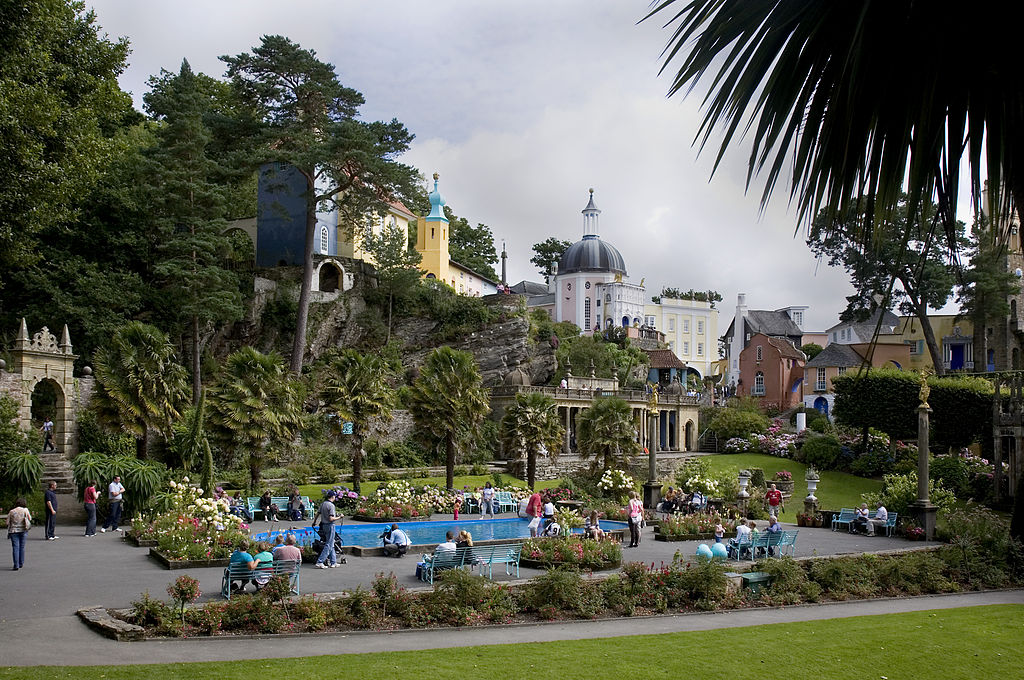It's 'An enchanting Italianate style village on the coast of North Wales', alright, but more on that in a minute.
It's fairly well known that this artificial destination, dogs not allowed, was built in an ornate, Mediterranean style by the not-so-well-known architect Clough Williams-Ellis. Fifty years he was on and off the job and he died just three years after its completion in 1975. If that could be considered bad timing, here's a temporal tip...
Pitch up just after 3 PM when the very nice, young, Welsh lad might let you in for less than half the admission fee. You really shouldn't need more than a couple of hours here and that includes a walk in the woods.
It's a monumental mishmash with Clough borrowing bits of Baroque, nicking from the Neoclassical and raiding the Renaissance for inspiration.

It was also assumed to be a proper place with proper people living in it and everything but no, most of what you can see are holiday rentals and extra rooms for the fancy hotel.
Those buildings that aren't are likely to be trying to sell you something including the Portmeirion pottery, which, if you flip over, you'll see is made in... Stoke-on-Trent!
If you think that's a little bit of a liberty and indicative of the place, it isn't and it's not. Clough's daughter Susan only set up shop in the Potteries where she designs, glazes and fires the stuff herself, probably.
This is all on a peninsula poking into an estuary and the original Welsh name roughly translates as 'frozen river mouth'.

Clough considered this unappealing to potential visitors and, this being the days before Saatchi & Saatchi™, he did all of the rebranding and penned the name Portmeirion himself.
The original Welsh name, by the way, is Aber Iâ even though even fewer people knew what it meant back then.
It's hard not to nod at Clough's achievement and his evident, not inconsiderable, talent but not for an entire afternoon.

After half-an-hour, the theme park feel will kick in so take yourself up to get a sense of your surroundings.
From the hotel at the bottom of the village, follow the shoreline south before heading up into Salutation Wood, all 70 acres of it.

There's as much thought gone into the landscaping as has gone into the building and it's reportedly very 'botanical'. Beyond a rhododendron, though, or a clear bottle with 'London' or 'Plymouth' printed on it, that's all outside SlyBob's area of knowledge.
If you're a skinflint, by the way, you could probably snuck into the place for free through here.
There's a toy choo-choo - thanks Eirian - that runs into the woods from the centre and they would in the past have been described as 'lazy bums'.

Given that the train will be being taken in 10 years time, nothing wrong with a friendly wave, eh?
Other wooded highlights include a pet cemetery and a Chinese pagoda, neither shown, but that's not what Portmeirion is most famous for, of course.
It's known that you know that SlyBob now know that it's probably best known as the setting for the barmy, '60s Sci-Fi caper The Prisoner and a little bit like the TV series Lost, they were making it up as they went along.

Unlike Lost, however, there never really was an explanation...
Was he really a prisoner?
Was it a test?
Was it a dream?
Who cares?
Missed it first time round but the oft-shown scene of McGoohan and a giant rubber ball just brings to mind Total Wipeout so no, it won't be getting watched anytime soon.


